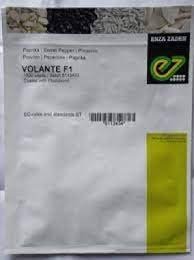Capcicum Seeds
Growing Capsicum (Bell Pepper) from Seeds: A Beginner’s Guide
If you’re looking to add some color and flavor to your garden, growing capsicum, commonly known as bell peppers, from seeds is a great option. Capsicums come in a variety of vibrant colors and can be enjoyed raw in salads, cooked in stir-fries, or stuffed and baked. In this beginner’s guide, we’ll walk you through the steps to successfully grow capsicum from seeds.
Selecting Capsicum Seeds:
When selecting capsicum seeds, you’ll find a wide range of options available, including different colors, sizes, and heat levels. Choose a variety that suits your taste preferences and growing conditions. You can find capsicum seeds at garden centers, nurseries, or online seed retailers. Popular varieties include red, yellow, orange, and green bell peppers, as well as sweeter or hotter pepper varieties.
Timing and Temperature:
Capsicums are warm-season vegetables that thrive in temperatures between 70°F and 85°F (21°C to 29°C). Start your capsicum seeds indoors 8 to 10 weeks before your region’s last frost date. This will give the seeds time to germinate and grow into sturdy seedlings before transplanting them into the garden. If you live in a mild climate, you can also sow capsicum seeds directly into the garden once the soil has warmed up in spring.
Preparing the Soil:
Capsicums prefer well-drained, fertile soil with a pH level between 6.0 and 6.8. Before planting, amend the soil with compost or aged manure to improve its texture and nutrient content. Remove any weeds and debris from the planting area to give your capsicum plants the best start. If you’re planting in containers, use a high-quality potting mix that drains well.
Planting Capsicum Seeds:
Fill seed trays or small pots with potting mix and moisten the soil thoroughly. Plant capsicum seeds 1/4 inch deep and space them 2 inches apart. Place the trays or pots in a warm, sunny location, such as a south-facing windowsill or under grow lights. Keep the soil consistently moist but not waterlogged, as excess moisture can cause the seeds to rot.
Transplanting Seedlings:
Once your capsicum seedlings have developed 2 to 4 true leaves and are 3 to 4 inches tall, they’re ready to be transplanted into the garden. Choose a sunny location with well-drained soil for planting. Space the seedlings 18 to 24 inches apart in rows spaced 24 to 36 inches apart. Gently remove the seedlings from their pots, taking care not to disturb the roots, and plant them at the same depth as they were in the pots.
Care and Maintenance:
To ensure healthy growth and abundant harvests, provide your capsicum plants with proper care and maintenance throughout the growing season. Here are some tips to keep in mind:
- Watering: Keep the soil evenly moist, especially during dry periods. Avoid overhead watering, as wet foliage can promote disease.
- Fertilizing: Feed your capsicum plants with a balanced fertilizer every 4 to 6 weeks, following the manufacturer’s instructions.
- Mulching: Apply a layer of mulch around the base of the plants to conserve moisture, suppress weeds, and regulate soil temperature.
- Support: As the capsicum plants grow, they may benefit from staking or caging to support their heavy fruit load.
- Pest and Disease Control: Monitor your capsicum plants regularly for signs of pests or diseases, such as aphids, caterpillars, or fungal infections. Take prompt action to address any issues and prevent them from spreading.
Harvesting Capsicum:
Capsicum plants typically begin producing fruit 60 to 90 days after transplanting. Harvest the peppers when they reach their mature size and color, but before they start to soften or wrinkle. Use a sharp knife or scissors to cut the peppers from the plants, leaving a short stem attached. Handle the peppers gently to avoid bruising or damaging the delicate skin.



